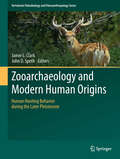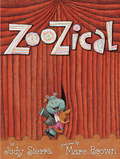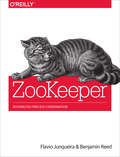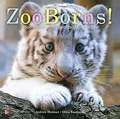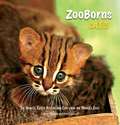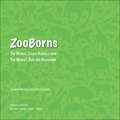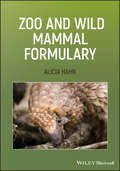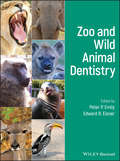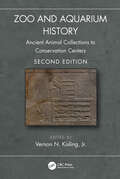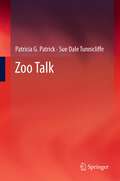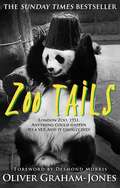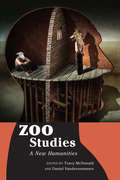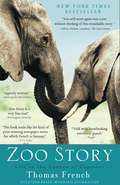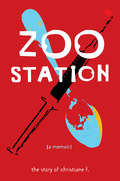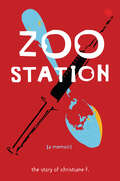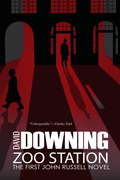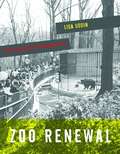- Table View
- List View
Zooarchaeology and Modern Human Origins: Human Hunting Behavior during the Later Pleistocene
by John D. Speth Jamie L. ClarkRecent genetic data showing that Neanderthals interbred with modern humans have made it clear that deeper insight into the behavioral differences between these populations will be critical to understanding the rapid spread of modern humans and the demise of the Neanderthals. This volume, which brings together scholars who have worked with faunal assemblages from Europe, the Near East, and Africa, makes an important contribution to our broader understanding of Neanderthal extinction and modern human origins through its focus on variability in human hunting behavior between 70-25,000 years ago--a critical period in the later evolution of our species.
Zooarchaeology
by Elizabeth J. Reitz Elizabeth S. WingThis book includes new sections on enamel ultra structure and incremental analysis, stable isotopes and trace elements, ancient genetics and enzymes, environmental reconstruction, people as agents of environmental change etc.
ZooZical: Read & Listen Edition
by Judy SierraWinter weather is keeping children from visiting the zoo. So the animals are out of sorts—listless, grumpy, and no longer fun. All except two little friends, a very small hippo and a baby kangaroo. Their hip-hopping, toe-tapping, and rap-rocking soon has the other animals joining in the hip-aroo beat—now brought to life with audio narration in this Read & Listen edition. "Raccoons danced in pairs, baboons danced in troops, and snakes joined the dancers as live hula-hoops." Children's favorite songs get a funny new spin—seals bark out "The seals on the bus go round and round"—as the animals create their very own musical.Young readers and listeners will be amazed and delighted at how the animals chase the winter doldrums by getting along as friends, pooling their talents, and pushing themselves to new heights. After all, these are the same clever animals who learned to read in Judy Sierra's and Marc Brown's Wild About Books, the award-winning New York Times #1 bestselling picture book. ZooZical is sure to inspire some "can do" fun in kindergarten and primary grades.This ebook includes Read & Listen audio narration.
ZooZical
by Marc Brown Judy SierraWinter weather is keeping children from visiting the zoo. So the animals are out of sorts--listless, grumpy, and no longer fun. All except two little friends, a very small hippo and a baby kangaroo. Their hip-hopping, toe-tapping, and rap-rocking soon has the other animals joining in the hip-aroo beat. "Racoons danced in pairs, baboons danced in troops, and snakes joined the dancers as live hula-hoops." Children's favorite songs get a funny new spin--seals bark out "The seals on the bus go round and round"--as the animals create their very own musical.Young readers and listeners will be amazed and delighted at how the animals chase the winter doldrums by getting along as friends, pooling their talents, and pushing themselves to new heights. After all, these are the same clever animals who learned to read in Judy Sierra's and Marc Brown's Wild About Books, an award-winning New York Times #1 bestselling picture book. ZooZical is sure to inspire some "can do" fun in kindergarten and primary grades.From the Hardcover edition.
ZooKeeper: Distributed Process Coordination
by Flavio Junqueira Benjamin ReedBuilding distributed applications is difficult enough without having to coordinate the actions that make them work. This practical guide shows how Apache ZooKeeper helps you manage distributed systems, so you can focus mainly on application logic. Even with ZooKeeper, implementing coordination tasks is not trivial, but this book provides good practices to give you a head start, and points out caveats that developers and administrators alike need to watch for along the way.In three separate sections, ZooKeeper contributors Flavio Junqueira and Benjamin Reed introduce the principles of distributed systems, provide ZooKeeper programming techniques, and include the information you need to administer this service.Learn how ZooKeeper solves common coordination tasksExplore the ZooKeeper API’s Java and C implementations and how they differUse methods to track and react to ZooKeeper state changesHandle failures of the network, application processes, and ZooKeeper itselfLearn about ZooKeeper’s trickier aspects dealing with concurrency, ordering, and configurationUse the Curator high-level interface for connection managementBecome familiar with ZooKeeper internals and administration tools
ZooBorns!: Zoo Babies From Around The World (Elementary Core Reading)
by Andrew Bleiman Chris EastlandNIMAC-sourced textbook
ZooBorns Cats!
by Andrew Bleiman Chris EastlandZooBorns showcases the newest and cutest animal babies from accredited zoos and aquariums around the world. With interesting animal facts and background stories on the featured babies, ZooBorns illustrates the connections between zoo births and conservation initiatives in the wild.
ZooBorns
by Andrew Bleiman Chris EastlandZooBorns showcases the newest and cutest animal babies from accredited zoos and aquariums around the world. With interesting animal facts and background stories on the featured babies, ZooBorns illustrates the connections between zoo births and conservation initiatives in the wild.
Zoo loco
by María Elena WalshLos personajes de Zoo Loco pasan por situaciones insólitas y hacen cosas absurdas. ¡Son unos verdaderos disparates!En estos poemas vas a averiguar por qué la lombriz se siente infeliz,qué dijo una pava en Ensenada, cuál es el secreto de la vieja tortugasin arrugas y otras ocurrencias del mundo animal que demuestran que elzoo está realmente loco.
Zoo and Wild Mammal Formulary
by Alicia HahnZoo and Wild Mammal Formulary offers fast access to authoritative dosing information for drugs used in more than 35 zoo and wild mammal groups, including marsupials, bears, and elephants. Taking an easy-to-use tabular format, the book is organized by taxa, with drug doses sorted by type and alphabetically arranged in every chapter. Clear and comprehensive, the book offers dosages for all important drugs, including antibiotics, antifungals, anesthetics, analgesics, and more. Each dose is referenced with a journal or textbook source, including the number of animals in the study where available, making it easy to find trusted information. Offers essential drug information for a wide range of zoo and wild mammals in an easy-to-consult format Provides dosing amounts for all important drugs, including antibiotics, antifungals, anesthetics, and analgesics Includes dosages for over 35 mammal groups, including marsupials, bears, and elephants Takes a tabular approach for quick reference Makes it easy to find a referenced dose for these animals, eliminating time spent searching through other sources Zoo and Wild Mammal Formulary is an essential reference for all veterinarians seeing zoo and wild animal patients, including zoo and wildlife veterinarians, veterinary specialists, and veterinary students.
Zoo and Wild Animal Dentistry
by Edward R. Eisner Peter P. EmilyZoo and Wild Animal Dentistry is the first book to offer a comprehensive reference to oral pathology and dental therapy in captive and wild exotic animals. Comprehensive in scope, the book is authored by noted experts on the topic who cover dental care for a broad range of species with an emphasis on oral health. Designed as a practical resource for treating exotic animals, the book is filled with instructive photographs and illustrations that clearly depict pathologies and demonstrate techniques. The book draws on the editors’ and contributors’ years of experience with exotic animals to offer a reliable resource to the history of veterinary dentistry, information on the evolution of teeth, practical dental therapeutics, and oral descriptions for each of the more than three hundred species included in the book. Zoo and Wild Animal Dentistry covers a wide range of zoo and wild species, including cats, bears, primates, dogs, raccoons, weasels, hyenas, marsupials, herbivores, edentates, sea mammals, birds, reptiles, and more. This important resource: Offers a comprehensive reference to oral pathology and dental therapy in captive and wild animals Highlights oral health to promote overall health Includes information on the most recent advances in the field Contains a groundbreaking resource for the dental care of exotic animals Written for zoo and wildlife caretakers and veterinarians, veterinary dentists, veterinary technicians, and veterinary students, Zoo and Wild Animal Dentistry is a practical resource that has information for the dental care of a wide range of animal species that are all too often neglected.
Zoo and Aquarium History: Ancient Animal Collections to Conservation Centers
by Vernon N. Kisling Jr.Wild animals have been housed in zoos and aquariums for 5,000 years, fascinating people living in virtually every society. Today, these institutions are at a new milestone in their history. This second edition of Zoo and Aquarium History takes the reader on a journey through the transition of private collections to menageries, to zoos, then zoological gardens, and more recently conservation centers and sanctuaries. Under the direction of Vernon N. Kisling, an expert in zoo history, an international team of authors has thoroughly updated the only comprehensive, global history of animal collections, menageries, zoos, and aquariums. The resulting book documents the continuum of efforts in maintaining wild animal collections from ancient civilizations through today, explaining how modern zoos have developed their mission statements around the core aims of conservation, education, research and recreation. This new edition pulls together regional information, including new chapters on zoological gardens of Canada, Latin America, China, Israel, the Middle East, and New Zealand, along with the cultural aspects of each region to provide a foundation upon which further research can be based. It presents a chronological listing of the world's zoos and aquariums and features many never-before published photographs. Sidebars present supplementary information on pertinent personalities, events, and wildlife conservation issues. The original Appendix has been expanded to include over 1,200 zoos and aquariums, providing an invaluable resource. This is an extensive, chronological introduction to the subject, highlighting the published and archival resources for those who want to know more.
Zoo Veterinarians: Governing Care on a Diseased Planet (Law, Science and Society)
by Irus BravermanDespite their centrality to the operation of contemporary accredited zoo and aquarium institutions, the work of zoo veterinarians has rarely, if ever, been the focus of a critical analysis in the social science and humanities. Drawing on in-depth interviews and observations of zoo and aquarium veterinarians in Europe and North America, this book highlights the recent transformation that has occurred in the zoo veterinarian profession during a time of ecological crisis, and what these changes can teach us about our rapidly changing planet. Zoo vets, Braverman instructs us with a wink, have "gone wild." Originally an individual welfare-centered profession, these experts are increasingly concerned with the sustainability of wild animal populations and with ecological health. In this sense, the story of zoo vets "going wild"—in their subjects of care, their motivations, and their ethical standards, as well as in their professional practices and scientific techniques—is also a story about zoo animals gone wild, wild animals encroaching the zoo, and, more generally, a wild world that is becoming "zoo-ified." Such transformations have challenged existing norms of veterinary practice. Exploring the regulatory landscape that governs the work of zoo and aquarium veterinarians, Braverman traverses the gap between the hard and soft sciences and between humans and nonhumans. At the intersection of animal studies, socio-legal studies, and Science and Technology Studies, this book will appeal not only to those interested in zoos and in animal welfare, but also to scholars in the posthumanities.
Zoo Talk
by Sue Dale Tunnicliffe Patricia G. PatrickFounded on the premise that zoos are 'bilingual'--that the zoo, in the shape of its staff and exhibits, and its visitors speak distinct languages--this enlightening analysis of the informal learning that occurs in zoos examines the 'speech' of exhibits and staff as well as the discourse of visitors beginning in the earliest years. Using real-life conversations among visitors as a basis for discussion, the authors interrogate children's responses to the exhibits and by doing so develop an 'informal learning model' and a 'zoo knowledge model' that prompts suggestions for activities that classroom educators can use before, during, and after a zoo visit. Their analysis of the 'visitor voice' informs creative suggestions for how to enhance the educational experiences of young patrons. By assessing visitors' entry knowledge and their interpretations of the exhibits, the authors establish a baseline for zoos that helps them to refine their communication with visitors, for example in expanding knowledge of issues concerning biodiversity and biological conservation. The book includes practical advice for zoo and classroom educators about positive ways to prepare for zoo visits, engaging activities during visits, and follow-up work that maximizes the pedagogical benefits. It also reflects on the interplay between the developing role of zoos as facilitators of learning, and the ways in which zoos help visitors assimilate the knowledge on offer. In addition to being essential reading for educators in zoos and in the classroom, this volume is full of insights with much broader contextual relevance for getting the most out of museum visits and field trips in general.
Zoo Tails
by Oliver Graham JonesOne puff adder, one antelope, one crocodile – This was the list of sick animals presented to Oliver Graham-Jones on his first day as a new vet at London Zoo in 1951. And his time at the zoo didn’t get any less strange or entertaining…There’s the time he anaesthetized, and was then chased by, a gorilla; had to capture an angry polar bear in thick fog; performed a colostomy on a python; and fitted a raven in the Tower of London with a wooden leg. And if an animal escaped (more frequently than you might think) or required urgent medical attention, he was always on hand, ready for any eventuality. With his self-deprecating humour, Oliver frequently described himself as quaking with fear, but he was also skilful, brave and, most of all, incredibly caring and kind to his animal patients.
Zoo Studies: Living Collections, Their Animals and Visitors
by Paul A. ReesZoos and aquariums are culturally and historically important places where families enjoy their leisure time and scientists study exotic animals. Many contain buildings of great architectural merit. Some people consider zoos little more than animal prisons, while others believe they play an important role in conservation and education. Zoos have been the subject of a vast number of academic studies, whose results are scattered throughout the literature. This interdisciplinary volume brings together research on animal behaviour, visitor studies, zoo history, human-animal relationships, veterinary medicine, welfare, education, enclosure design, reproduction, legislation, and zoo management conducted at around 200 institutions located throughout the world. The book is neither 'pro-' nor 'anti-' zoo and attempts to strike a balance between praising zoos for the good work they have done in the conservation of some species, while recognising that they face many challenges in making themselves relevant in the modern world.
Zoo Studies: A New Humanities
by Tracy McDonald Daniel VandersommersDo both the zoo and the mental hospital induce psychosis, as humans are treated as animals and animals are treated as humans? How have we looked at animals in the past, and how do we look at them today? How have zoos presented themselves, and their purpose, over time? In response to the emergence of environmental and animal studies, anthropologists, sociologists, philosophers, theorists, literature scholars, and historians around the world have begun to explore the significance of zoological parks, past and present. <P><P> Zoo Studies considers the modern zoo from a range of approaches and disciplines, united in a desire to blur the boundaries between human and nonhuman animals. The volume begins with an account of the first modern mental hospital, La Salpêtrière, established in 1656, and the first panoptical zoo, the menagerie at Versailles, created in 1662 by the same royal architect; the final chapter presents a choreographic performance that imagines the Toronto Zoo as a place where the human body can be inspired by animal bodies. From beginning to end, through interdisciplinary collaboration, this volume decentres the human subject and offers alternative ways of thinking about zoos and their inhabitants. This collection immerses readers in the lives of animals and their experiences of captivity and asks us to reflect on our own assumptions about both humans and animals. <P><P> An original and groundbreaking work, Zoo Studies will change the way readers see nonhuman animals and themselves.
Zoo Studies: A New Humanities
by Tracy McDonald and Daniel VandersommersDo both the zoo and the mental hospital induce psychosis, as humans are treated as animals and animals are treated as humans? How have we looked at animals in the past, and how do we look at them today? How have zoos presented themselves, and their purpose, over time? In response to the emergence of environmental and animal studies, anthropologists, sociologists, philosophers, theorists, literature scholars, and historians around the world have begun to explore the significance of zoological parks, past and present. Zoo Studies considers the modern zoo from a range of approaches and disciplines, united in a desire to blur the boundaries between human and nonhuman animals. The volume begins with an account of the first modern mental hospital, La Salpêtrière, established in 1656, and the first panoptical zoo, the menagerie at Versailles, created in 1662 by the same royal architect; the final chapter presents a choreographic performance that imagines the Toronto Zoo as a place where the human body can be inspired by animal bodies. From beginning to end, through interdisciplinary collaboration, this volume decentres the human subject and offers alternative ways of thinking about zoos and their inhabitants. This collection immerses readers in the lives of animals and their experiences of captivity and asks us to reflect on our own assumptions about both humans and animals. An original and groundbreaking work, Zoo Studies will change the way readers see nonhuman animals and themselves.
Zoo Story: Life in the Garden of Captives
by Thomas French"This story, told by a master teller of such things, does more than take you inside the cages, fences, and walls of a zoo. It takes you inside the human heart, and an elephant's, and a primate's, and on and on. Tom French did in this book what he always does. He took real life and wrote it down for us, with eloquence and feeling and aching detail."-Rick Bragg, Pulitzer Prize-winning journalist and bestselling author"An insightful and detailed look at the complex life of a zoo and its denizens, both animal and human."-Yann Martel, author of Life of Pi and Beatrice and VirgilWelcome to the savage and surprising world of Zoo Story, an unprecedented account of the secret life of a zoo and its inhabitants. Based on six years of research, the book follows a handful of unforgettable characters at Tampa's Lowry Park Zoo: an alpha chimp with a weakness for blondes, a ferocious tiger who revels in Obsession perfume, and a brilliant but tyrannical CEO known as El Diablo Blanco. The sweeping narrative takes the reader from the African savannah to the forests of Panama and deep into the inner workings of a place some describe as a sanctuary and others condemn as a prison. Zoo Story shows us how these remarkable individuals live, how some die, and what their experiences reveal about the human desire to both exalt and control nature.
Zoo Station: The Story of Christiane F.
by Christina Cartwright Christiane F.In 1978 Christiane F. testified against a man who had traded heroin for sex with teenage girls at Berlin's notorious Zoo Station. In the course of that trial, Christiane F. became connected with two journalists, and over time they helped to turn her story--which begins with a dysfunctional but otherwise fairly normal childhood--into an acclaimed bestseller. Christiane F.'s rapid descent into heroin abuse and prostitution is shocking, but the boredom, the longing for acceptance, the thrilling risks, and even the musical obsessions that fill out the rest of Christiane's existence will be familiar to every reader. Christiane F.'s Berlin is a strange and often terrifying place, but it's also a place that remains closer than we might think....
Zoo Station: The Story of Christiane F.
by Christiane F.This incredible autobiography of Christiane F. provides a vivid portrait of teen friendship, drug abuse, and alienation in and around Berlin's notorious Zoo Station. Christiane's rapid descent into heroin abuse and prostitution is shocking, but the boredom, longing for acceptance, thrilling risks, and even her musical obsessions are familiar to everyone. Previously published in Germany and the US to critical acclaim, Zest's new translation includes original photographs of Christiane and her friends.
Zoo Station (John Russell #1)
by David DowningBy 1939, Anglo-American journalist John Russell has spent over a decade in Berlin, where his son lives with his mother. He writes human-interest pieces for British and American papers, avoiding the investigative journalism that could get him deported. But as World War II approaches, he faces having to leave his son as well as his girlfriend of several years, a beautiful German starlet. When an acquaintance from his old communist days approaches him to do some work for the Soviets, John Russell is reluctant, but he is unable to resist the offer. He becomes involved in other dangerous activities, helping a Jewish family and a determined young American reporter. When the British and the Nazis notice his involvement with the Soviets, Russell is dragged into the murky world of warring intelligence services. David Downing grew up in suburban London and is the author of numerous works of fiction and nonfiction for adults and children, including The Moscow Option, Russian Revolution 1985,and The Red Eagles.
Zoo Station
by Christiane F Christina CartwrightIn 1978 Christiane F. testified against a man who had traded heroin for sex with teenage girls at Berlin's notorious Zoo Station. In the course of that trial, Christiane F. became connected with two journalists, and over time they helped to turn her story--which begins with a dysfunctional but otherwise fairly normal childhood--into an acclaimed bestseller. Christiane F.'s rapid descent into heroin abuse and prostitution is shocking, but the boredom, the longing for acceptance, the thrilling risks, and even the musical obsessions that fill out the rest of Christiane's existence will be familiar to every reader. Christiane F.'s Berlin is a strange and often terrifying place, but it's also a place that remains closer than we might think....
Zoo Station
by Christiane F Christina CartwrightIn 1978 Christiane F. testified against a man who had traded heroin for sex with teenage girls at Berlin's notorious Zoo Station. In the course of that trial, Christiane F. became connected with two journalists, and over time they helped to turn her story--which begins with a dysfunctional but otherwise fairly normal childhood--into an acclaimed bestseller. Christiane F.'s rapid descent into heroin abuse and prostitution is shocking, but the boredom, the longing for acceptance, the thrilling risks, and even the musical obsessions that fill out the rest of Christiane's existence will be familiar to every reader. Christiane F.'s Berlin is a strange and often terrifying place, but it's also a place that remains closer than we might think....
Zoo Renewal: White Flight and the Animal Ghetto (A Quadrant Book)
by Lisa UddinWhy do we feel bad at the zoo? In a fascinating counterhistory of American zoos in the 1960s and 1970s, Lisa Uddin revisits the familiar narrative of zoo reform, from naked cages to more naturalistic enclosures. She argues that reform belongs to the story of cities and feelings toward many of their human inhabitants. In Zoo Renewal, Uddin demonstrates how efforts to make the zoo more natural and a haven for particular species reflected white fears about the American city—and, pointedly, how the shame many visitors felt in observing confined animals drew on broader anxieties about race and urban life. Examining the campaign against cages, renovations at the National Zoo in Washington, D.C. and the San Diego Zoo, and the cases of a rare female white Bengal tiger and a collection of southern white rhinoceroses, Uddin unpacks episodes that challenge assumptions that zoos are about other worlds and other creatures and expand the history of U.S. urbanism. Uddin shows how the drive to protect endangered species and to ensure larger, safer zoos was shaped by struggles over urban decay, suburban growth, and the dilemmas of postwar American whiteness. In so doing, Zoo Renewal ultimately reveals how feeling bad, or good, at the zoo is connected to our feelings about American cities and their residents.
